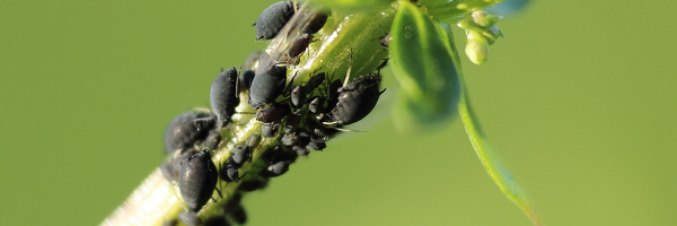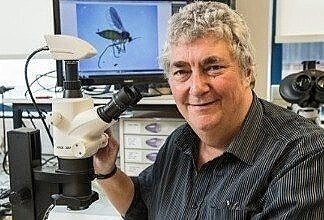
Battle black bean aphids in your garden this summer
What is the Black Bean aphid?
One of the most common aphids to be found on garden plants throughout the growing season is the black bean aphid, Aphis fabae, commonly referred to as ‘blackfly’ by gardeners and growers. Black bean aphids are first seen during early spring, having hatched from eggs that were laid on shrubs such as viburnum and euonymous during autumn.Clustering on the shrub’s tender new shoots, the young aphids insert their stylets into the leaf tissue to suck on sap and mature into adult female aphids. The females begin giving birth to around a dozen live young each day, live young that already have live youngsters growing inside them, too. This rapid reproduction rate results in dense colonies of black bean aphids appearing on the shrubs. However, these infestations are unlikely to cause lasting damage to the shrubs since, by late spring the shrub’s new leaves will have become too tough for the aphids to feed from and the aphid colonies will begin to subside.

How do black bean aphids survive during the summer?
The shortage of sap now affecting the survival of the aphids causes the colony to produce winged females (alates), which disperse from the shrubs to find new tender-leaved plants that they can establish new colonies. These will include dahlias, poppies, and various legumes, which soon become heavily infested with hundreds of aphids as they voraciously feed on the sap and reproduce.
When these new aphid colonies become overpopulated and cause harm to their host plants, they won’t need to produce winged females to disperse to new hosts again, as black bean aphids establish a mutualistic relationship with the Black Garden ant Lasius niger who will carry and transfer the aphids to new host plants when required, whilst protecting them from predators such as ladybirds. The ants farm the aphids throughout the growing season to harvest and consume the rich sugary honeydew that the aphids excrete.
By the end of summer, when tender-leafed plants begin to wither, the black bean aphid colonies start to decline, and the ants depart. Toward the end of the summer season, colonies produce another batch of winged aphids, which include males amongst the females. These then disperse from the colony and complete the black bean aphids annual lifecycle by mating and laying overwintering eggs on the shrubs again.
For gardeners and growers who wish to control black bean aphids during the growing season, but not harm the ants, a thorough and direct application of SB Plant Invigorator a non-toxic surfactant-based product can be used.
When these new aphid colonies become overpopulated and cause harm to their host plants, they won’t need to produce winged females to disperse to new hosts again, as black bean aphids establish a mutualistic relationship with the Black Garden ant Lasius niger who will carry and transfer the aphids to new host plants when required, whilst protecting them from predators such as ladybirds. The ants farm the aphids throughout the growing season to harvest and consume the rich sugary honeydew that the aphids excrete.
By the end of summer, when tender-leafed plants begin to wither, the black bean aphid colonies start to decline, and the ants depart. Toward the end of the summer season, colonies produce another batch of winged aphids, which include males amongst the females. These then disperse from the colony and complete the black bean aphids annual lifecycle by mating and laying overwintering eggs on the shrubs again.
For gardeners and growers who wish to control black bean aphids during the growing season, but not harm the ants, a thorough and direct application of SB Plant Invigorator a non-toxic surfactant-based product can be used.

About Dr Ian Bedford
Ian has been fascinated by the bug world for as long as he can remember. From studying butterflies on the South Downs as a youngster, he went on to pursue a career in Research Entomology and ran the Entomology Dept at the John Innes Centre in Norwich up until his recent retirement.VISIT WEBSITE

'Bug of the month'
Visit our 'bug of the month' archive.
Every month Ian will share his knowledge on how to protect your plants and gardens from preventable pest invasions while providing valuable insights into the insects regularly found in our gardens.
find out more
Comments (0)
Why not be the first to send us your thoughts?
